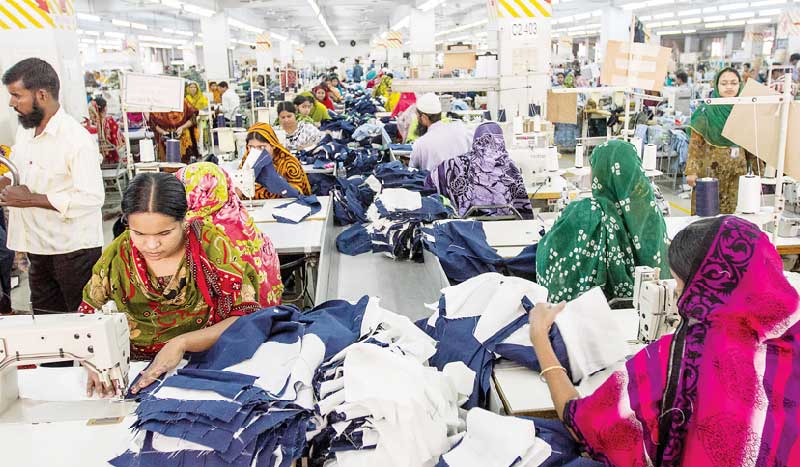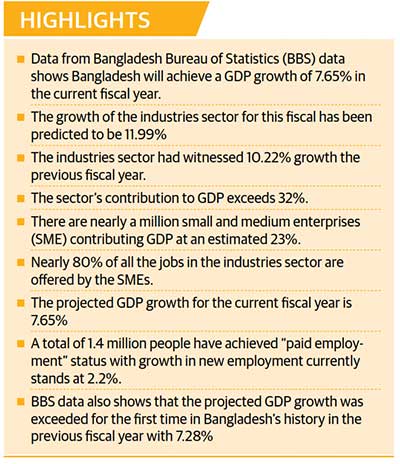Published in Dhaka Tribune on Sunday, 08 April 2018
Industries sector driving record GDP growth
Golam Mowla

According to BBS data, Bangladesh will achieve a GDP growth of 7.65% in the current fiscal year, exceeding an earlier prediction of 7.4%
Standing on the shoulders of the country’s industries sector, Bangladesh is on the verge of achieving a new record in GDP growth for Fiscal Year (FY) 2017-18.
According to Bangladesh Bureau of Statistics (BBS) data, Bangladesh will achieve a GDP growth of 7.65% in the current FY, exceeding an earlier prediction of 7.4%. The data also confirmed that the industries sector is the key driver of this projected growth.
On Tuesday, Planning Minister AHM Mustafa Kamal highlighted the growth in the industries sector during at a meeting of the Executive Committee of the National Economic Council (Ecnec).
The growth of the industries sector for this fiscal has been predicted to be 11.99%, according to data presented by the minister at the meeting. BBS data show that the industries sector had witnessed 10.22% growth the previous fiscal year.
At present, the sector’s contribution to GDP exceeds 32%. There are nearly a million small and medium enterprises (SME) in Bangladesh. The contribution of these SMEs to GDP is an estimated 23%.
Nearly 80% of all the jobs in the industries sector are offered by the SMEs.
Center for Policy Dialogue (CPD) Research Director Khondaker Golam Moazzem said: “The BBS data clearly highlights the industries sector’s huge contribution to GDP.
“Growth in all three types of industries – large, medium, and small – is quite good compared to the previous FY. The export and the domestic industries sectors have both moved forward.”
Bangladesh Institute of Development Studies (BIDS) Research Director and Agrani Bank Chairman Dr Zaid Bakht believes that the industries sector is making a positive impact on GDP growth.
“Government investment has increased in this FY, which also caused the private investments to increase. Import of industry machinery and raw materials has increased. These factors are contributing to GDP growth,” he said.

What about other sectors?
The BBS data revealed that the growth in the service sector has slowed down. But it is unclear whether the slowdown is affecting the employment rate.
Addressing the issue, Golam Moazzem said: “There is confusion about the BBS growth prediction for the agriculture sector, as floods severely damaged crops across the country, especially the Amon paddy this fiscal year.”
“Because of the floods, rice prices increased, leading to a spike in food grain imports, which could affect growth in this sector negatively.”
Explaining the growth prediction, the planning minister had earlier said: “The production of Aush paddy and jute has increased this fiscal, along with the production of fish. The industries sector witnessed increased production capabilities due to the improved supply of gas and electricity.
“Production in sectors such as garments, pharmaceuticals, cement, and cattle feed has increased. Wholesale and retail dealings in the service sector increased compared to the previous FY.”
The minister continued: “The construction sector also witnessed growth. Projects such as Padma Multipurpose Bridge and Dhaka Mass Rapid Transit Development have provided a boost to development activities.”
According to the data revealed by the planning minister, the projected GDP growth for the current fiscal year is 7.65%. As part of the prediction, the agriculture and the service sectors would see growth of 3.06% and 6.33% respectively, while the industries sector would achieve 11.99% growth.
Sources from the BBS pointed out that in the previous FY, the agriculture sector witnessed a growth of 2.9%, industries sector of 10.22%, and service sector of 6.69%.
Employment and labour force
The labour force survey report by the BBS revealed that a total of 3.7 million people gained employment in FY 2016-2017.
In the industries sector, only 200,000 people gained employment during the same period.
According to the bureau, the growth of new employment opportunities in the industries sector has been slow so far.
In 2013, this sector employed around 12.1 million people. The number of employees stood at around 12.2 million in FY 2015-16 and 12.4 million in FY 2016-17.
The BBS report further stated that among the effective workforce of around 109.1 million people, around 2.68 million currently remain unemployed.
A total of 1.4 million people have achieved “paid employment” status and another one million found jobs and work abroad. The growth in new employment currently stands at 2.2%.
Of the growth in employment, male employment increased by 0.7%, while female employment increased by 4.8%.
In FY 2016-17, the service sector employed a total of 23.7 million. This increased by 1.7 million in the current fiscal year.
The BBS data also mentioned that the projected GDP growth was exceeded for the first time in Bangladesh’s history in the previous FY. The government had projected a growth of 7.2%, but 7.28% growth was achieved that FY.


